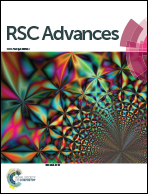Novel water-soluble phosphatriazenes: versatile ligands for Suzuki–Miyaura, Sonogashira and Heck reactions of nucleosides†
Abstract
Two new water-soluble phosphatriazene ligands have been synthesized as versatile ligands for complexation reactions with Pd(OAc)2 and utilized for catalyzing column-free Suzuki–Miyaura cross-coupling of various purine and pyrimidine halonucleosides in water. The water-solubility of the catalytic system simplified the isolation of the cross-coupled products to mere filtration, while the catalytically active solution in the filtrate was recycled eight times. A novel copper-free Sonogashira coupling protocol for the nucleosides has also been established via a one-pot synthesis of FV-100, a nucleoside-based drug in phase 3 clinical trials for herpes zoster or shingles treatment. Application of the Heck reaction was demonstrated by the synthesis of another antiviral drug: BVDU.


 Please wait while we load your content...
Please wait while we load your content...